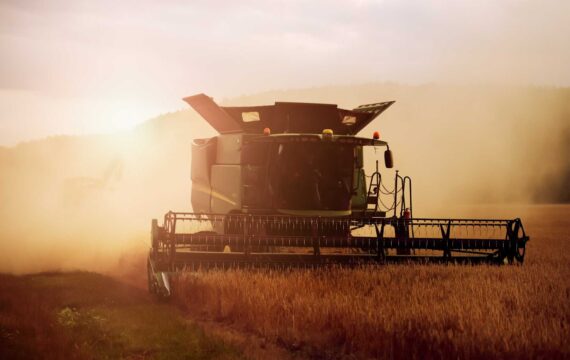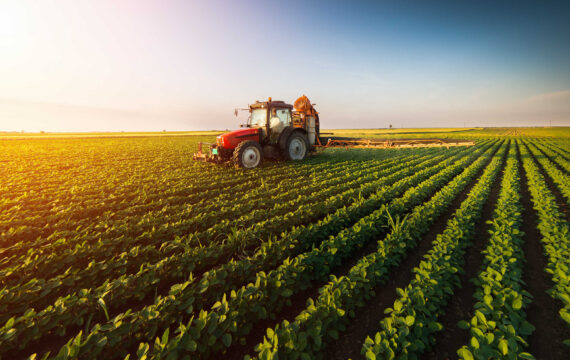Any discussion of agribusiness in 2023 would be incomplete without considering the key trends and innovations in agriculture. Here’s why.
In the last two decades, global production of primary crops has increased by more than 50%. How did agricultural companies manage to double their production in twenty years, and how can they achieve even more impressive results in the face of a growing global population? The short answer is innovative agricultural technologies.
Agricultural businesses can no longer afford to rely on intuition-based decisions, human-centered processes, and technologies born in previous centuries. The winners of tomorrow will be those implementing innovations in agriculture today. Find out what the future of farming will look like by exploring new technologies in agriculture. Let’s get started!
What’s inside?
- Why IoT innovations in agriculture will make you forget conventional farming approaches
- Embrace the inevitable: AI, ML, and predictive analytics in AgriTech
- How the blockchain brings innovative ideas on agriculture to life
- Automation trends in agriculture break new ground
- The future is here: vertical and indoor farming
- Geographic information systems (GIS) for enhanced field management
Why IoT innovations in agriculture will make you forget conventional farming
Connected farming is one of the most promising trends in agriculture, helping us understand how agricultural businesses can produce enough food to meet growing demand.
Connected farming is about using new technologies in agriculture to monitor, manage, control, and ultimately improve key agricultural and farming processes at the pre-production, production, and post-production stages of the farming cycle.
Connected farming is implemented through an ecosystem of diverse IoT devices that gather and exchange data in the field, within equipment, in the cloud, and in corporate offices.
Monitoring fields is a good use case to show how farming innovations like IoT technology can replace inefficient and time-consuming approaches. Imagine a dozen sensors out in a field tracking the soil condition, air temperature, and humidity level. Once the level of a particular parameter reaches a yellow zone, a manager or field operator receives a real-time notification so they can take necessary actions.
As the system is highly customizable, it can be adjusted in a way that human involvement would in some cases not be required. For instance, inputs from sensors may instantly trigger aerial or ground-based irrigation drones.

IoT innovative agricultural technologies are already being employed for diverse connected farming applications. Major use cases include:
- Integrated data collection via diverse types of field and farm sensors, including autonomous vehicles sensors, controllers, wearables, and video cameras
- Geofencing powered by wireless IoT sensors to manage access to fields
- Remote greenhouse and field management through IoT-based monitoring powered by 4G, LoRaWAN, Wi-Fi, LTE-M, and other connectivity technologies
- Drones and robotics for irrigation, crop health control and assessment, field spraying, etc.
- Data-driven reporting and predictive analytics for key weather and field parameters
Embrace the inevitable: AI, ML, and predictive analytics in AgriTech
At every stage of the agricultural lifecycle, farmers must make dozens of timely and effective decisions. In the past, crop choice, soil preparation, fertilizer use, seed sowing, irrigation, weed protection, harvesting, and storage were determined by decisions based on instincts, manual calculations, and subjective opinions.
Today, agricultural decision-makers can save plenty of time, get accurate predictions, and make better decisions using innovative ideas on agriculture powered by machine learning (ML) and artificial intelligence (AI) technologies.
Innovative agricultural technologies based on AI and ML can be used for diverse purposes, from predictive analytics for crop sustainability and demand forecasting to proactive identification of weed and crop infections and sustainable harvesting with minimized waste. Another use of new technologies in agriculture is AI-based robots. These can be applied in various ways, such as for smart cattle herding.

Simply put, AI-driven farming innovations offered on the market can be divided into two groups: the Swiss army knife type that provide a diverse set of functionality and more specific solutions with limited yet deep specializations.
Now, think of a solution generating data-driven analytics and farm-level reports that help agriculturalists assess the performance of field inputs on crops and reveal the weaknesses of the crop management process. The value for an agricultural business may hardly be overestimated. Yet mass adoption of AI-based farming innovations is still being undermined by end users’ lack of trust in algorithms in general and the black box problem in particular. The good news is that explainable AI is gaining momentum, which means more and more farmers will embrace AI soon.
How the blockchain brings innovative ideas on agriculture to life
It’s impossible not to mention the blockchain when speaking of key innovations in agriculture and farming. Blockchain and distributed ledger technology (DLT) are already being used at almost every stage of the agricultural business cycle to:
- simplify the agricultural supply chain
- enhance food safety and eliminate counterfeit items
- track complete product paths from field to store
- reduce financial risks and promote fair trade
- provide certifications required by authorities
- provide farmers and businesses with smooth financial and insurance services
To give an idea of how developing trends in agriculture work in practice, let’s look at how a blockchain helps farmers manage insurance policies.
Largely because farming has always been vulnerable to unpredictable weather and climate changes, insurance services are crucial for the financial health of an agricultural business.
If you’ve ever worked with farms in harsh climates or within impoverished communities, you know that claiming indemnity payments becomes a monthly or even weekly routine. And that’s where new technologies in agriculture and the blockchain come into play, reducing risks for stakeholders, speeding up claims processes, and eliminating human mistakes.
With a blockchain-based smart contract, indemnity payments can be automatically triggered once contractual conditions are met. For example, if monthly precipitation doesn’t reach a particular level specified in a contract, a farmer can automatically get an indemnity payment within a contracted period. Smart contracts developed with distributed ledger technology make the indemnity payment process quick, easy, and safe.
Automation trends in agriculture break new ground
The value of the agricultural robotics industry is likely to quadruple by 2025, growing from $4.6 billion in 2020 to over $20 billion. An industry that has always been associated with extensive use of manual labor is now taking a course on robotization and automation. This and other future trends in agriculture demonstrate the challenges of a growing global population, which leaves farmers no choice but to become more efficient.

Today, automated machinery including drones, watering machines, and smart tractors are used to substitute manual labor for repetitive tasks and processes. The result is an optimization of human resources used in harvesting, fruit picking, spraying, planting, seeding, and weeding.
Take GPS-led remotely controlled vehicles used for harvesting as an example. A single operator can manage and control dozens of these vehicles at the same time. Eventually, overall productivity is improved while the risks of human-induced mistakes are minimized.
Innovations in agriculture are not only about machines replacing manual labor. They’re also about the automation of processes and instant actions triggered by particular data-driven insights.
Here’s an example: UAV crop monitoring goes through several stages. First, a farmer selects objects and lands to be monitored by drones. Then the drones collect images of those objects and lands. Next, these images are sorted so only relevant data remains. After the selected data is analyzed, reports and insights are generated. Finally, automated actions are triggered (e.g. field irrigation) with no minute wasted or mistake made. This is how agriculture industry trends work in practice.
The future is here: vertical and indoor farming
Global climate change has led to extreme weather conditions which, in turn, result in a shortage of land for agricultural purposes. Governments and businesses are joining efforts to bring innovative ideas on agriculture to populated urban areas, deserts, and other lands where traditional farming practices and approaches do not work.
Controlled environment agriculture (CEA) is one of the key new technologies in agriculture that will define the future of sustainable farming. CEA uses just the right mix of light, humidity, air temperature, and nutrients to ensure that plants get everything needed wherever they are growing.
The agriculture trend of indoor and vertical farming is made possible by CEA. Indoor and vertical farms can be built in almost any part of the world, regardless of the surrounding geography and climate conditions.
Imagine a large agricultural complex producing diverse types of crops in the middle of a desert, or a farm inside a space station. This is no longer science fiction. Future trends in agriculture are already here. Besides the ability to grow crops in almost any climate and weather conditions, the benefits of vertical farming include:
- Minimized risks of pests and disease
- Reduced need to use chemicals, pesticides, and herbicides
- Lower costs on labor and harvesting machinery
- Year-round productivity
- Accurate irrigation systems, which can reduce water use by 90%
- Real-time monitoring and control over farm conditions to sustain the perfect conditions for each plant
- Savings on land maintenance, machinery, labor, and herbicides significantly outweigh initial investments

Vertical farming is directly linked to new technologies in agriculture, such as hydroponics and aeroponics, that make it possible to grow plants using liquid nutrient mediums or steam instead of soil.
Another sustainable agricultural technique used in vertical farming is aquaponics, which refers to the simultaneous cultivation of plants and fish. In aquaponics, plants purify the water for fish while fish supply the plants with nutrients.
Geographic information systems (GIS) for enhanced field management
In farming, field yields depend on the quality and sustainability of land development. That’s why land assessment and management are so important. In the past, land management relied on field sample analyses, physical observations, and, of course, a lot of guesswork and gut feelings.
Today, geographic information system (GIS) technology is gaining momentum as an alternative to outdated approaches. Let’s see how innovations in agriculture are transforming land management.
GIS solutions enable spatial representations of any field or other geographic entity by means of hardware, software, and big data. The hardware — satellites, GPS systems, automated vehicles, or drones — receives and locates data points, which are then transferred to and analyzed by an integrated central system.
In the end, farmers get a map displaying up-to-date crop positions and health statuses, precipitation amounts, topographical details, soil type and elevation, fertilization statistics, wind speed and direction, flooding, slope aspect, field erosion, and more. The precise data set can be customized depending on business needs and field specifications.

When discussing future trends in agriculture, you might have heard the term “satellite farming,” as satellites remain the core hardware device fueling GIS with data. However, regardless of the device used for GIS, the practical implications of a GIS system include:
- Irrigated terrain mapping
- Drainage modeling
- Livestock monitoring
- Flooding, erosion, and drought control
- Crop quality evaluation and control
- Land degradation estimation
- Insect and pest control
- Irrigation parameter analysis
- Erosion surveillance and management
Wrapping up
Forget the old-fashioned technologies firmly associated with farming for centuries. In 2023, agriculture has barely anything in common with the conventional notions of farming. Last year, a total of $12.8 billion was invested in food and agriculture tech, and there are good reasons to expect a new investment record in 2023.
In the face of global challenges, including record-breaking population growth and climate change, sustainability trends in agriculture and farming are imperative. The only means to ensure enough food for growing demand is the use of innovations in agriculture.
Tech companies are already helping agricultural businesses around the globe to secure strategic growth, profitability, and effectiveness by implementing innovative ideas on agriculture. Kick off your farming innovations today to become a trendsetter tomorrow!
Contact us to find the right blend of new technology that will help your company reach its goals, accelerate production, and gain an upper hand in the agricultural market.




